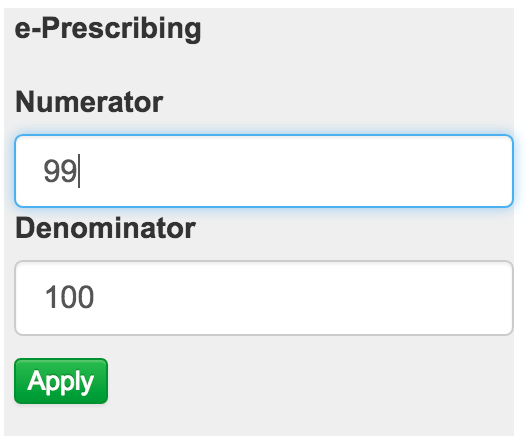What is Promoting Interoperability?
This performance category promotes patient engagement and electronic exchange of information using certified electronic health record technology (CEHRT). This performance category is worth 25% of your MIPS Final Score for 2023.
MIPS eligible clinicians must use the following to collect and report their Promoting Interoperability data:
- Technology certified to the 2015 Edition Cures Update criteria.
If you select the last 90-days in 2023 as your performance period, the 2015 Edition Cures Update must be in place by October 3, 2023. Your EHR must be certified to the 2015 Edition Cures Update by Dec 31, 2023.
Not sure what Edition your EHR is?
Search for your EHR on the Certified Health IT Product List (CHPL) website: https://chpl.healthit.gov/#/search.
Do you think you might qualify for an exception for PI?
You may qualify for a re-weighting of the Promoting Interoperability performance category (to 0% and Quality becomes 55% of your score) if you meet certain criteria: https://qpp.cms.gov/mips/exception-applications
CMS will apply automatic re-weighting to the following, beginning with the 2023 performance period:
- Small practices
- Clinical social workers
- Physical therapists
- Occupational therapists
- Qualified speech-language pathologists
- Qualified audiologists
- Clinical psychologists, and
- Registered dieticians or nutrition professionals
CMS is discontinuing automatic reweighting for the following clinician types beginning with the 2023 performance period:
- Nurse practitioners
- Physician assistants
- Certified registered nurse anesthetists
- Clinical nurse specialist
All Promoting Interoperability measures can be easily reported with MDinteractive:
- Log into your account and click on the Add/Edit link next to the PI category. Note: If you do not see this on your homepage, please begin by entering or loading your NPI/TIN combination or just TIN if reporting as a group.
- Enter your minimum 90 day reporting period (required).
- Complete the pre-attestation questions by choosing "yes" for each.
- Enter the Numerator and Denominator, derived from reports run off of your EHR, for each measure into MDinteractive (or claim exclusion if applicable).
- Upload supporting documentation.

There are 4 objectives:
- Objective: e-prescribing
- e-Prescribing (10 points)**
- Query of Prescription Drug Monitoring Program (PDMP) (10 points)**
- Objective: Provider to Patient Exchange
- Objective: Health Information Exchange
- Support Electronic Referral Loops by Sending Health Information (Option 1: 15 points)**
- Support Electronic Referral Loops by Receiving and Reconciling Health Information (Option 1: 15 points)**
- Health Information Exchange (HIE) Bi-Directional Exchange (Option 2: 30 points)
- Enabling Exchange under TEFCA (Option 3: 30 points)
- Objective: Public Health and Clinical Data Exchange (report 2 measures for 10 points)
- CMS will require reporting of the Immunization Registry Reporting and Electronic Case Reporting (unless an exclusion can be claimed).
- The Public Health Registry Reporting, Clinical Data Registry Reporting, and Syndromic Surveillance Reporting measures will be optional and MIPS eligible clinicians could earn 5 bonus points if they report a “yes” response for any one of them. Note reporting more than one of these optional measures won’t result in more than 5 bonus points.
**There are exclusions available for most of the measures. If you meet and claim the exclusion for one or more of the required Promoting Interoperability performance category measures, the points for the measure will be redistributed to another measure or measures as follows:
- e-Prescribing exclusion - 10 points are redistributed equally among the Health Information Exchange objective - each becomes 25 points.
- Support Electronic Referral Loops by Sending Health Information exclusion - 20 points are redistributed to Provider to Patient Exchange objective making it worth 60 points (vs. 40).
- Support Electronic Referral Loops by Receiving and Incorporating Health Information exclusion - 20 points are redistributed to Support Electronic Referral Loops by Sending Health Information measure making it worth 40 points (vs. 20).
- Public Health and Clinical Data Exchange exclusion - if 2 different measures are excluded, the 10 points are redistributed to Provider to Patient Exchange objective making this measure worth 50 points.
Promoting Interoperability Required Attestations
- Perform or Review a Security Risk Analysis. The actions included in the Security and Risk Analysis measure are still required to be performed (attest yes) during the calendar year in which the performance period occurs, but it is an unscored measure.
- Perform an Annual Assessment of the High Priority Guide (from the SAFER Guides). Beginning with 2022 MIPS there will be a new attestation:
- Conduct an annual self-assessment using the High Priority Practices Guide at any point during the calendar year in which the performance period occurs. One can attest with a “yes” or a "no". A “no” will also satisfy this measure.
- The High Priority Practices Guide of the Safety Assurance Factors for EHR Resilience (SAFER) Guides can be found here
- To complete the self-assessment, one must complete a review and mark the associated checkboxes (fully, partially, or not implemented) of recommended practices included in the beginning of the Guide.
- Detailed worksheets with the rationale for, and examples of how, to implement each recommended practices follows the checklist section of the Guide.
- These worksheets include likely sources of information that your practice may reference to complete your assessment of a recommended practice, as well as fillable note fields to record follow-up actions.
- Complete the Actions to Limit or Restrict Interoperability of CEHRT Attestation. This attestation statement aims to identify whether you or your health IT vendor acted in good faith and took necessary steps to prevent limiting or restricting the compatibility or interoperability of CEHRT.
- To complete this attestation, you will attest to the statement by entering a “yes” (certify that you acted in good faith when implementing and using your CEHRT to exchange electronic health information) or “no” (you don’t certify that you acted in good faith when implementing and using your CEHRT to exchange electronic health information) response.